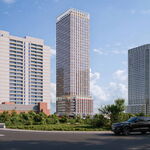Northern Light
Superstar
The City and Waterfront Toronto are continuing to work on the Gardiner East and Lake Shore East (Port Lands Flood Protection Project) . See: https://portlandsto.ca/about/
They keep talking about the rail spur that goes (or went) to the Ashbridges Bay Sewage plant. The line was cut when the City approved the new Canada Post building at Leslie & Commissioners without checking that the line could be moved over onto the road allowance. (Only after it was removed did anyone realise that there are utilities under the road (surprise!) so the rail line cannot go on top.) Clearly the rail spur is dead (it has also just been cut again at the Don River and they removed it at Cherry & Unwin last fall. However, the plans still show it in the median of the new Lake Shore so I asked what was up. Here is the reply:
"Thanks for your email and question regarding the rail spur. There are no firm updates at this time, however we’re told that City staff are studying it in the context of the Broadview extension Environmental Assessment. The city’s process includes reaching out to stakeholders.
The decision to keep or remove the rail spur will come from the City of Toronto, not Waterfront Toronto. Currently, as there is no direction to remove it, the design must incorporate it into the road configuration."
It would seem better if they bit the bullet and said "it's gone than wasting any time/money/space on planning for it in the median! Silos!!!
Absurd.
If they waste any $$$ building a railway track that will be disused from day 1, and removed within a few years.........






/https://www.thestar.com/content/dam/thestar/news/gta/2021/08/28/we-are-just-waiting-to-see-who-will-be-the-last-farmer-left-prime-farmland-in-the-gta-is-disappearing-fast-doug-fords-growth-plan-may-be-making-that-worse/farm_main.jpg)
/https://www.thestar.com/content/dam/thestar/news/gta/2021/08/28/we-are-just-waiting-to-see-who-will-be-the-last-farmer-left-prime-farmland-in-the-gta-is-disappearing-fast-doug-fords-growth-plan-may-be-making-that-worse/gtha_growth_plan_forecast.jpg)